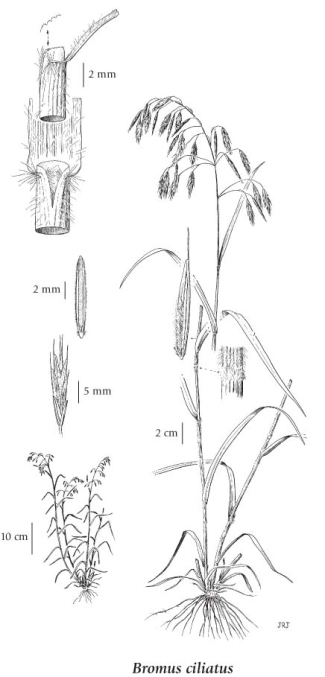Bromus ciliatus L.
fringed brome
Poaceae (Grass family)
Introduction to Vascular Plants
fringed brome
Poaceae (Grass family)
Introduction to Vascular Plants
Species Information click to expand contents
General:
Perennial grass from fibrous roots; stems usually hairy at the nodes but sometimes smooth, 50-100 cm tall.
Leaves:
Sheaths usually open for 1-2 cm, smooth (or the throats fringed with long, fine hairs) to thickly soft-hairy; blades 5-10 (15) mm wide, lax, flat, smooth to soft-hairy on the upper surfaces and sometimes the lower ones; ear-shaped lobes lacking at the leaf-bases; ligules minutely jagged and fringed with fine hairs, 0.5-1 (1.5) mm long.
Notes:
Bromus ciliatus is a variable species with some plants having either shorter anthers or differences in hairiness. The phase, B. richardsonii, recognized by Welsh (1974) and Pavlick (1995) has so many overlapping characters with B. ciliatus that its recognition appears meaningless, even at a subspecific level. I have followed the treatments by Hitchcock and Chase (1951), Hitchcock (1969), Holmgren and Holmgren (1977) and Wilken and Painter (1993) which submerge B. richardsonii within B. ciliatus.
Illustration click to expand contents

If more than one illustration is available for a species (e.g., separate illustrations were provided for two subspecies) then links to the separate images will be provided below. Note that individual subspecies or varietal illustrations are not always available.
Illustration Source: The Illustrated Flora of British Columbia
USDA Species Characteristics click to expand contents
Flower Colour:
Yellow
Blooming Period:
Spring
Fruit/Seed characteristics:
Colour: Brown
Present from Spring to Summer
Source: The USDA
Ecology click to expand contents
Ecological Framework for Bromus ciliatus
The table below shows the species-specific information calculated from
original data (BEC database) provided by the BC Ministry of Forests and Range.
(Updated August, 2013)
The table below shows the species-specific information calculated from
original data (BEC database) provided by the BC Ministry of Forests and Range.
(Updated August, 2013)
| Site Information |
Value / Class |
||
|
Avg |
Min |
Max |
|
| Elevation
(metres) |
1140 | 8 | 1950 |
| Slope
Gradient (%) |
18 | 0 | 90 |
|
Aspect (degrees) |
179 | 0 | 360 |
| Soil
Moisture Regime (SMR) [0 - very xeric; 4 - mesic; 8 - hydric] |
4 | 0 | 8 |
| Modal
Nutrient Regime
Class |
D | ||
| #
of field plots species was recorded in: |
468 | ||
| Modal
BEC Zone Class |
SBS | ||
|
All BEC Zones (# of stations/zone) species was recorded in |
BG(1), BWBS(26), CWH(4), ESSF(92), ICH(73), IDF(51), MS(83), PP(2), SBPS(15), SBS(103), SWB(2) | ||
|
Source:
Klinkenberg 2013
|
|||
Habitat and Range click to expand contents
Wet streambanks and lake margins to mesic meadows and open forests in the montane zone; frequent in BC in and E of the Coast-Cascade Mountains; N to AK, YT and NT, E to NF and S to ME, MA, PA, NC, NE, TX, NM, AZ and CA.